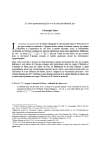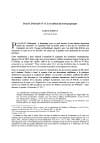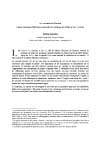Époque Ptolémaïque
« Le ciel septentrional ghr.t et le ciel mĂ©ridional gb.t »
ENiM 2, 2009, p. 53-58.
 Cette brève note lexicographique concerne le terme ghr.t, attesté par quelques
exemples provenant des temples gréco-romains de la région thébaine et par le P. Carlsberg I,
qui conduit à une traduction plus précise : « voûte céleste septentrionale ».
Cette brève note lexicographique concerne le terme ghr.t, attesté par quelques
exemples provenant des temples gréco-romains de la région thébaine et par le P. Carlsberg I,
qui conduit à une traduction plus précise : « voûte céleste septentrionale ».
 The subject of this short lexicographical note concerns the word ghr.t, attested in few
examples from the graeco-roman temples of the Theban area and in the P. Carlsberg I, which
leads to the most accurate translation “Northerly sky vault”.
The subject of this short lexicographical note concerns the word ghr.t, attested in few
examples from the graeco-roman temples of the Theban area and in the P. Carlsberg I, which
leads to the most accurate translation “Northerly sky vault”.
 Consulter cet article (49931) -
Consulter cet article (49931) -  Télécharger cet article au format pdf (26139)
Télécharger cet article au format pdf (26139)
« Polybe, PtolĂ©mĂ©e IV et la tradition historiographique »
ENiM 2, 2009, p. 91-101.
 Les historiens antiques et à leur suite, un grand nombre d'historiens modernes, ont sévèrement critiqué le quatrième souverain de l'Égypte hellénistique, Ptolémée Philopator, et au delà de la figure historique, leur jugement s'est naturellement focalisé sur le bilan de son règne. Cet état de fait tient en grande partie à la tradition transmise par Polybe et reprise par ses successeurs. Cependant, une remise en question de cette vision trop négative est perceptible depuis une quarantaine d´années grâce à une relecture des sources et à une analyse nouvelle des faits (dont certains inconnus des historiens de la première moitié du XXe siècle). Cet article propose de faire un point sur cette question.
Les historiens antiques et à leur suite, un grand nombre d'historiens modernes, ont sévèrement critiqué le quatrième souverain de l'Égypte hellénistique, Ptolémée Philopator, et au delà de la figure historique, leur jugement s'est naturellement focalisé sur le bilan de son règne. Cet état de fait tient en grande partie à la tradition transmise par Polybe et reprise par ses successeurs. Cependant, une remise en question de cette vision trop négative est perceptible depuis une quarantaine d´années grâce à une relecture des sources et à une analyse nouvelle des faits (dont certains inconnus des historiens de la première moitié du XXe siècle). Cet article propose de faire un point sur cette question.
 The ancient historians and at their turn, a large number of modern historians have severely criticized the forth sovereign of Hellenistic Egypt, Ptolemy IV Philopator and beyond the historic figure, they based their judgment on the facts of his reign. This situation is, in large part, the result of the tradition transmitted by Polybius and taken over by his successors. Nevertheless, this very negative perspective has been looked at differently during the last forty years due to reviewing the sources and reanalyzing the facts (some of which were unknown to the historians of the first half of the 20th century). This article aims to make a point in this matter.
The ancient historians and at their turn, a large number of modern historians have severely criticized the forth sovereign of Hellenistic Egypt, Ptolemy IV Philopator and beyond the historic figure, they based their judgment on the facts of his reign. This situation is, in large part, the result of the tradition transmitted by Polybius and taken over by his successors. Nevertheless, this very negative perspective has been looked at differently during the last forty years due to reviewing the sources and reanalyzing the facts (some of which were unknown to the historians of the first half of the 20th century). This article aims to make a point in this matter.
 Consulter cet article (50366) -
Consulter cet article (50366) -  Télécharger cet article au format pdf (26032)
Télécharger cet article au format pdf (26032)
« Le cercueil de Peniou. MusĂ©e national d’Histoire naturelle de Santiago du Chili (no inv. 11.160) »
ENiM 2, 2009, p. 109-128.
 L’analyse du cercueil de Pȝ-n(y)-jw (XXXe dyn. – dĂ©but de l’époque ptolĂ©maĂŻque ; MusĂ©e d’histoire naturelle de Santiago du Chili – MNHN 11.160) permet de mettre en lumière l’emploi d’une boiserie en trompe-l’œil originale et son rapport avec diffĂ©rents motifs religieux, notamment deux figures d’Anubis anthropomorphe adoptant la posture ksw.
L’analyse du cercueil de Pȝ-n(y)-jw (XXXe dyn. – dĂ©but de l’époque ptolĂ©maĂŻque ; MusĂ©e d’histoire naturelle de Santiago du Chili – MNHN 11.160) permet de mettre en lumière l’emploi d’une boiserie en trompe-l’œil originale et son rapport avec diffĂ©rents motifs religieux, notamment deux figures d’Anubis anthropomorphe adoptant la posture ksw.
 The analysis of the Pȝ-n(y)-jw’s coffin (Dynasty 30 – Ptolemaic Period; Museo Nacional de Historia Natural, Santiago of Chile – MNHN 11.160) allows to throw a light on the use of an original woodwork in trompe l’oeil and his relationship with various religious motives, specially two anthropomorphic Anubis in the ksw posture.
The analysis of the Pȝ-n(y)-jw’s coffin (Dynasty 30 – Ptolemaic Period; Museo Nacional de Historia Natural, Santiago of Chile – MNHN 11.160) allows to throw a light on the use of an original woodwork in trompe l’oeil and his relationship with various religious motives, specially two anthropomorphic Anubis in the ksw posture.
 Consulter cet article (54536) -
Consulter cet article (54536) -  Télécharger cet article au format pdf (25104)
Télécharger cet article au format pdf (25104)
« Motif iconographique des boĂ®tes Ă pieds sur les parures de cartonnage de momies d’époque ptolĂ©maĂŻque. Collection du MusĂ©e des Confluences Ă Lyon »
ENiM 16, 2008, p. 1-41.
 Des momies datées de l’époque ptolémaïque, appartenant à la collection du musée des Confluences à Lyon, portant une parure de cartonnage, présentent la particularité d’un motif iconographique original sur les parois latérales des boîtes à pieds. Ce motif représente un animal fantastique composite transportant la momie d’Osiris dans le royaume des morts. Le défunt se tient en attitude d’adoration devant la créature divine chargée de le protéger dans son parcours dans l’au-delà . Cet article étudie les variantes de la scène funéraire à partir de neuf exemplaires conservés dans la collection et tente d’y apporter des éléments d’interprétation.
Des momies datées de l’époque ptolémaïque, appartenant à la collection du musée des Confluences à Lyon, portant une parure de cartonnage, présentent la particularité d’un motif iconographique original sur les parois latérales des boîtes à pieds. Ce motif représente un animal fantastique composite transportant la momie d’Osiris dans le royaume des morts. Le défunt se tient en attitude d’adoration devant la créature divine chargée de le protéger dans son parcours dans l’au-delà . Cet article étudie les variantes de la scène funéraire à partir de neuf exemplaires conservés dans la collection et tente d’y apporter des éléments d’interprétation.
 Mummies dating from the Ptolemaic period, belonging to the collection of the musée des Confluences in Lyon, wearing a cartonnage set, present the particularity of an original iconographic scene on the lateral faces of foot case. This scene represents a fantastic composite animal carrying Osiris’s mummy in the Deads’ kingdom. The deceased is in an attitude of adoration before the divin creature that gives him protection during his way in Netherworld. This paper studies the different versions of the funerary scene from nine copies kept in the collection and try to give some interpretation elements.
Mummies dating from the Ptolemaic period, belonging to the collection of the musée des Confluences in Lyon, wearing a cartonnage set, present the particularity of an original iconographic scene on the lateral faces of foot case. This scene represents a fantastic composite animal carrying Osiris’s mummy in the Deads’ kingdom. The deceased is in an attitude of adoration before the divin creature that gives him protection during his way in Netherworld. This paper studies the different versions of the funerary scene from nine copies kept in the collection and try to give some interpretation elements.
 Consulter cet article (24332) -
Consulter cet article (24332) -  Télécharger cet article au format pdf (7412)
Télécharger cet article au format pdf (7412)
ENiM 18 - 2025
4 article(s) - 11 mars 2025.
ENiM 1 à 18 (2008-2025) : 223 articles
4 023 050 téléchargements
8 341 965 consulations.
Index des auteurs

Mots clés

Derniers articles : 
Robert Steven Bianchi
Duplication and Continuity
(ENiM 18, p. 13-36 — 11 mars 2025) 
Frédéric Mougenot
Rénénoutet à la porte de la maison
(ENiM 18, p. 1-12 — 29 janvier 2025) 
CENiM - Mise en ligne des volumes Ă©puisĂ©s : 
 Anne-Sophie von BOMHARD DĂ©cans Ă©gyptiens, CENiM 23, Montpellier, 2020 — (2020)
Anne-Sophie von BOMHARD DĂ©cans Ă©gyptiens, CENiM 23, Montpellier, 2020 — (2020) 
 Jean-Claude Grenier L'Osiris ANTINOOS, CENiM 1, Montpellier, 2008 — (26 dĂ©cembre 2008)
Jean-Claude Grenier L'Osiris ANTINOOS, CENiM 1, Montpellier, 2008 — (26 dĂ©cembre 2008) 
TDENiM - Mise en ligne des volumes Ă©puisĂ©s : 
 Twitter
Twitter 3617328 visites - 10948 visite(s) aujourd’hui - 70 connecté(s)
© ENiM - Une revue d’égyptologie sur internet
Équipe Égypte Nilotique et Méditerranéenne - UMR 5140 - « Archéologie des Sociétés Méditerranéennes » (Cnrs) - Université Paul Valéry - Montpellier III

























 Contact
Contact
 Abonnez-vous !
Abonnez-vous ! Équipe Égypte Nilotique et Méditerranéenne
Équipe Égypte Nilotique et Méditerranéenne UMR 5140 « Archéologie des Sociétés Méditerranéennes » (Cnrs)
UMR 5140 « Archéologie des Sociétés Méditerranéennes » (Cnrs) Université Paul Valéry - Montpellier III
Université Paul Valéry - Montpellier III